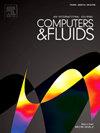粘性不可压缩流的改进压力梯度法
IF 3
3区 工程技术
Q3 COMPUTER SCIENCE, INTERDISCIPLINARY APPLICATIONS
引用次数: 0
摘要
压力梯度法以压力梯度而非压力作为未知变量来求解粘性不可压缩流动。压力梯度法的两个变体在过去已被开发出来,但由于其性能不理想或实施复杂,并未受到广泛关注。基于人工可压缩性概念,本研究提出了一种改进的压力梯度法。该方法的一个显著特点是不需要压力/压力梯度边界条件,也不需要对壁面边界进行特殊处理。引入了一个辅助变量来表示速度扩张,从而大大简化了空间离散和计算过程。详细阐述了数学公式,并与之前的压力梯度方法进行了比较,随后讨论了兼容性关系、边界条件设置以及压力泊松方程的扩展。针对不同的流动情况进行了四次验证,并检查了每种情况下的解决方案和域电磁性。研究还比较了相关的计算方法、不同的压力边界条件和流动特性,展示了本方法的优势。本文章由计算机程序翻译,如有差异,请以英文原文为准。
An improved pressure gradient method for viscous incompressible flows
The pressure gradient method solves the viscous incompressible flow with the pressure gradients, rather than the pressure, as unknown variables. Two variants of the pressure gradient method have been developed in the past but have not received much attention due to their unsatisfactory performance or implementation complexity. Based on the artificial compressibility concept, this study proposes an improved pressure gradient method. One distinct feature of this method is that it requires no pressure/pressure gradient boundary condition or special treatment on wall boundaries. An auxiliary variable is introduced to represent the velocity dilatation, greatly simplifying the spatial discretization and computational procedure. The mathematical formulations are elaborated and compared with the previous pressure gradient methods, followed by discussions of compatibility relationships, boundary condition setup, and an extension to a pressure Poisson-like equation. Four validation examples are performed for various flow scenarios, and the solutions and domain solenoidity are examined for each case. The study also compares associated computational methods, different pressure boundary conditions, and flow characteristics, demonstrating the benefits of the present method.
求助全文
通过发布文献求助,成功后即可免费获取论文全文。
去求助
来源期刊

Computers & Fluids
物理-计算机:跨学科应用
CiteScore
5.30
自引率
7.10%
发文量
242
审稿时长
10.8 months
期刊介绍:
Computers & Fluids is multidisciplinary. The term ''fluid'' is interpreted in the broadest sense. Hydro- and aerodynamics, high-speed and physical gas dynamics, turbulence and flow stability, multiphase flow, rheology, tribology and fluid-structure interaction are all of interest, provided that computer technique plays a significant role in the associated studies or design methodology.
 求助内容:
求助内容: 应助结果提醒方式:
应助结果提醒方式:


